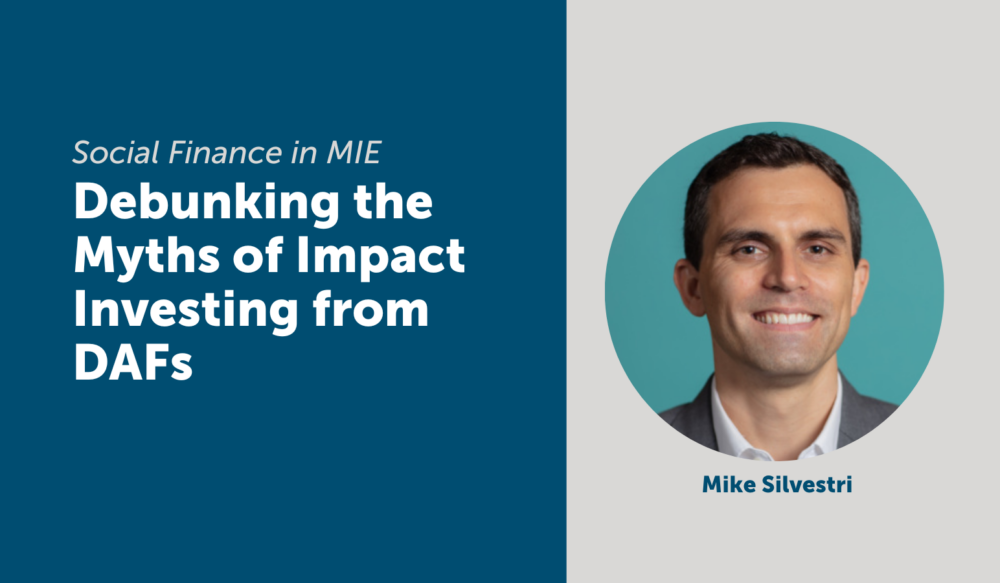

Impact Investments, Social Finance Impact First Fund
Key Takeaway
Many misconceptions discourage DAF providers from pursuing impact investments. Vice President, Impact Investing Mike Silvestri debunks the myths surrounding impact investing, explaining how Social Finance mobilizes DAF capital to drive meaningful change and achieve both social and financial returns.
This article originally appeared in Mission Investors Exchange in February 2025.
A real estate investment fund that helps homeowners refinance predatory mortgages. A growth equity fund that invests in companies that bring opportunity to rural communities. A place-based workforce fund that provides no-interest loans to upskill workers and helps the community thrive.
These and other promising market-based solutions benefit from grant capital, but grant capital is scarce. A far vaster pool of capital — investment capital — could bring these solutions to scale if only more capital allocators were ready and willing to invest for both impact and financial returns.
Our mission at Social Finance is to help allocators, particularly those at foundations and donor-advised funds (DAFs), embrace impact investing — especially with capital that is already earmarked for charitable use.
Over a trillion dollars in DAF and other philanthropic assets remain on the sidelines despite being tax-advantaged and earmarked for charity, while promising market-based solutions to our world’s most pressing challenges go underfunded.
In our conversations with DAF providers, we often hear the same refrains about impact investing repeated: impact investments are too fringe, or too complicated, or too expensive to pursue. Yet, these concerns are often grounded in incorrect assumptions or a lack of full information. Exposing these myths is an essential step to unlocking more DAF capital towards impact investments and building the world these philanthropic vehicles were intended to create.
Myth #1: Donors aren’t interested in impact investing.
Many DAF sponsors believe their donors are content with the traditional grow-and-give DAF strategy. In our experience, the opposite is true. Our national DAF donor survey found that over 70% of donors were interested in making impact investments through their DAFs. Demand is highest among younger, “next gen” donors, but interest spans ages, account sizes, and geographies. Moreover, a majority indicated they would accept below market-rate returns and longer lock-up periods in exchange for deep impact.
In the time since our survey, these findings have held up in the “real world” of DAF impact investing. In 2020, the Jewish Community Federation and Endowment Fund (JCFEF) implemented an impact lending program for its donors. Approximately 100 donors have embraced this opportunity since, mobilizing over $50 million of DAF capital through impact loans to 24 nonprofits and mission-driven financial institutions. A growing number of community foundations — including the San Francisco Foundation, the Topeka Community Foundation, the Baltimore Community Foundation, the Montana Community Foundation, and others — have gone a step further, implementing automatic allocations from DAFs into their local, impact investing pools.
Today, over 100 community foundations have impact investing programs or offerings for their donors — a number that attests to the growing popularity of this approach among DAF holders. The evidence suggests launching an impact investment offering is unlikely to repel donors, but not having one might.
Myth #2: Running an impact investing program is too expensive.
Many DAF providers assume that when it comes to impact investing, the juice is not worth the squeeze. The reality is that, in our experience, the relative costs of an impact investment program can be quite small compared to the costs of investment consultants and program teams. And often, management fees that can be charged on impact investment assets are enough to cover the costs of operating the portfolio.
In our own partnerships with DAF providers, we have found that DAF donors are willing to cover some of the costs of an impact investing program. For example, in our recent work with a major community foundation, we saw 73% weighted average participation in a voluntary 2% donation to cover administrative costs associated with sourcing and managing impact investments. And if DAF holders transfer their assets elsewhere to make impact investments, delaying an impact investment offering may be the most expensive scenario of all.
Myth #3: There aren’t enough investable opportunities.
This “pipeline” myth — that there are not enough viable impact opportunities available — persists despite overwhelming evidence to the contrary. There are more than 1,400 Community Development Financial Institutions (CDFIs) in the U.S that channel low-cost capital towards pressing local issues like housing, economic development, childcare, and clean energy. CDFIs offer a low-risk, low barrier to entry approach to impact investing. Other public lists of impact-focused funds abound, like those maintained by Impact Alpha and Impact Assets. Social Finance maintains an ever-growing proprietary database of over 700 promising “impact-first” investment opportunities that have the primary purpose of generating impact outcomes and from which financial return is expected but secondary. We have also supported even relatively small and/or rural DAF sponsors in surfacing dozens of local investable opportunities through landscape scans and grantee surveys. A massive pipeline awaits the DAF spigot to be opened.
Myth #4: Impact investing conflicts with fiduciary duty.
Those concerned that impact investments violate fiduciary duty mistakenly believe either (1) that all opportunities are inherently bad — or “imprudent” — investments, (2) that impact is irrelevant to the determination of prudence, and/or (3) that impact investments even need to meet standards of prudence in the first place. Let’s examine these three misconceptions.
First, most impact investors surveyed by the Global Impact Investing Network (GIIN) report pursuing mainly competitive, market-rate returns with their impact investments. Many of these investments boast financial performance that would, putting impact aside, readily meet the standards for prudent investment for tax-exempt organizations. It’s important to remember that impact investments — like all investments — span asset classes, risk level, and financial return targets.
Second, there certainly are impact investments, including many impact-first investments, that carry higher risk or earn below-market rate returns in exchange for greater impact. And traditional investors therefore often pass on these investments for prudence reasons — but that may be a mistake. While it can seem challenging to demonstrate that these investments meet traditional standards of prudence, in many cases it is still possible due to an important, but often overlooked, fact: charitable purpose is one of the seven factors that should be considered in evaluating an investment’s prudence.
Third, even if an impact investment wouldn’t be deemed prudent after weighing those seven factors, many believe that, for charitable purpose organizations like DAF providers, impact investments do not need to meet a standard of prudence if the investment assets are held primarily for charitable purposes and not primarily for investment purposes. Impact-first investment assets that align with the charitable purpose of the DAF should be able to easily fulfill this criterion because the impact purpose is explicitly primary to the financial purpose.
Myth #5: There’s no rush or it’s not the right time.
To leaders who acknowledge the value of impact investment programs but feel no urgency to get involved, we say, time is impact. The UN estimates that between $5.4 and $6.4 trillion are needed per year between now and 2030 to achieve our Sustainable Development Goals. Grant capital alone is not nearly enough to address the scale of this need before the window of opportunity closes.
It’s not just impact on the table — there is also a business case to be made for impact investing. Impact investment programs can help community foundations and other specialty DAF sponsors compete with large national sponsors (who may charge lower fees) by attracting donors interested in future-forward approaches to philanthropy. The rapid growth of ImpactAssets, a DAF sponsor whose entire investment portfolio is impact-oriented, supports this assertion. In 2018, the firm’s assets totaled $474 million; in 2024, an impressive $3 billion.
Finally, in the face of mounting regulatory and public pressures (everything from the ACE Act to proposed IRS regulations to the #HalfMyDAF movement), impact investments offer DAF sponsors an opportunity to challenge the perception that impact can only be achieved through grant payouts.
Myth #6: It’s too complicated.
The final myth we encounter is the belief that impact investment programs are just too complicated to start. Who is the right person within a foundation to lead this (with investment teams on one side of the house and grantmaking teams on the other)? How will an already at-capacity staff handle the logistical and legal hurdles? Where will they find the resources to rigorously diligence opportunities, track cashflows, or report on impact?
These concerns are valid, but there are ways for DAF sponsors to “dip their toes in” and access support.
One such entry point is through recoverable grants. These impact-first vehicles allow a DAF sponsor to quickly deploy capital using their existing grantmaking infrastructure.
To make more complex impact investments, foundations can access additional expertise or capacity from external advisors, including Social Finance. For investors looking for more plug-and-play options, “one-stop solutions” like our Social Finance Impact First Fund do the upfront work of sourcing, vetting, and monitoring opportunities, so all donors have to do is invest.
Impact investing is more than within reach for DAFs, and the time is now. By embracing the opportunity, DAFs can amplify their impact and meet the moment.
To get started, contact Social Finance, and consider joining other communities of impact investors like Mission Investors Exchange (MIE). For more, join the MIE Community Foundations member gathering on Feb. 20, 2025.
Disclosure
Related Insight
